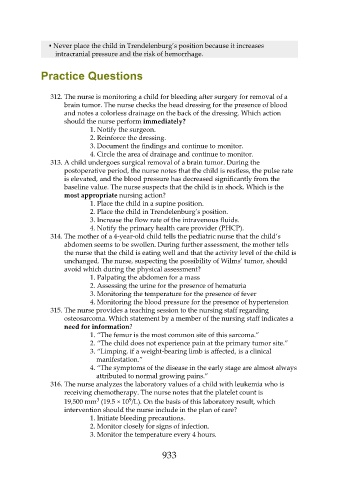Page 933 - Saunders Comprehensive Review For NCLEX-RN
P. 933
▪ Never place the child in Trendelenburg’s position because it increases
intracranial pressure and the risk of hemorrhage.
Practice Questions
312. The nurse is monitoring a child for bleeding after surgery for removal of a
brain tumor. The nurse checks the head dressing for the presence of blood
and notes a colorless drainage on the back of the dressing. Which action
should the nurse perform immediately?
1. Notify the surgeon.
2. Reinforce the dressing.
3. Document the findings and continue to monitor.
4. Circle the area of drainage and continue to monitor.
313. A child undergoes surgical removal of a brain tumor. During the
postoperative period, the nurse notes that the child is restless, the pulse rate
is elevated, and the blood pressure has decreased significantly from the
baseline value. The nurse suspects that the child is in shock. Which is the
most appropriate nursing action?
1. Place the child in a supine position.
2. Place the child in Trendelenburg’s position.
3. Increase the flow rate of the intravenous fluids.
4. Notify the primary health care provider (PHCP).
314. The mother of a 4-year-old child tells the pediatric nurse that the child’s
abdomen seems to be swollen. During further assessment, the mother tells
the nurse that the child is eating well and that the activity level of the child is
unchanged. The nurse, suspecting the possibility of Wilms’ tumor, should
avoid which during the physical assessment?
1. Palpating the abdomen for a mass
2. Assessing the urine for the presence of hematuria
3. Monitoring the temperature for the presence of fever
4. Monitoring the blood pressure for the presence of hypertension
315. The nurse provides a teaching session to the nursing staff regarding
osteosarcoma. Which statement by a member of the nursing staff indicates a
need for information?
1. “The femur is the most common site of this sarcoma.”
2. “The child does not experience pain at the primary tumor site.”
3. “Limping, if a weight-bearing limb is affected, is a clinical
manifestation.”
4. “The symptoms of the disease in the early stage are almost always
attributed to normal growing pains.”
316. The nurse analyzes the laboratory values of a child with leukemia who is
receiving chemotherapy. The nurse notes that the platelet count is
3
9
19,500 mm (19.5 × 10 /L). On the basis of this laboratory result, which
intervention should the nurse include in the plan of care?
1. Initiate bleeding precautions.
2. Monitor closely for signs of infection.
3. Monitor the temperature every 4 hours.
933

